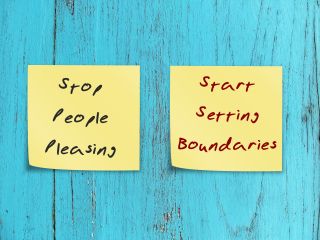Autism
The Problematic Issue of Boundaries and Autism
Personal Perspective: Inability to understand boundaries leads to social problems.
Posted January 14, 2023 Reviewed by Gary Drevitch
Key points
- One of autism's defining features is social deficits and impairments which can lead to people with autism not understanding boundaries.
- Lack of understanding of boundaries leads to many of the social struggles people with autism have.
- Helping people with autism understand boundaries is critical.

I have struggled with friendships since childhood. This is intrinsic to autism. According to the DSM-V-TR, the diagnostic criteria for autism include: “Deficits in social-emotional reciprocity, deficits in nonverbal communication used in social interactions, and deficits in developing, maintaining, and understanding relationships across a variety of contexts.” Like most people with autism, I meet all of these diagnostic criteria. As a child, this meant if I could keep one friend for a year or two it was a win. As an adult, this looks like a long chain of failed friendships and loves.
Recently, a friend group I had been in completely dissolved. I struggled to understand all the reasons my friend groups always dissolve but I was able to sit down with my aunt, a notable social worker from Michigan—Kathleen Guiles, LICSW—and she helped me understand a major piece of the puzzle. She said, “It seems like you have no understanding of boundaries.”
I thought about it. I understand boundaries from a textbook perspective. I can set them in extreme situations but I realize that I probably violate others' boundaries and let other violate mine all the time. This is because my social impairment makes it difficult for me to see when a boundary is being violated. It is also because I have been trained since childhood to mask my autism and focus on others' needs above my own. My position as a therapist actually makes this worse. In this last situation, a woman entered my friend group a year-and-a-half ago and immediately began talking about the women in the group with me. I handled her constant negative talk of others like a therapist. I tried to help her set textbook boundaries and stop enabling and confront them. I became her counselor and I reacted to all of her behavior like a counselor, but the damage we were doing was far-reaching. I began to perceive my friend’s behavior exclusively through her perceptive lens. My advice to her led to fracturing within the group as she began confronting everyone and telling everyone it was because I thought they were toxic. Slowly, friends left the group.
I both violated, and let my boundaries be violated, without seeing it. I didn’t tell this woman I was her friend and not her therapist. I didn’t set the boundary that she shouldn’t talk about other people behind their backs. I didn’t tell my friends about what was happening as I saw her discussions with me as confidential from a therapeutic standpoint. Since over time I related to her more and more as a client, it never occurred to me that she was also talking about me behind my back as well. It never occurred to me that she was painting a picture of me that was just as toxic as the picture she painted of others. I took everything she said at face value and never questioned the validity of what she was telling me. The relationship progressed at an unnaturally rapid pace and became weirdly codependent. I was unable to perceive this. So, when she left the group rapidly and reattached to another group with equal zest, I was left to analyze why my friend group had completely dissolved in her presence and how my inability to set boundaries or respect the boundaries of my friends had played a role in this. The problem was her need to constantly talk about everyone behind their back and justify this behavior saying we were toxic, but it was also with me neither establishing boundaries nor really understanding where I should have set them. I was just happy to have a friend who craved deep closeness and did whatever I could to maintain this closeness including violating my boundaries and those of others within the group.
This is a fundamental problem with all relational interactions for people with autism. Since we have had deficits in developing, maintaining, and understanding relationships in almost all contexts, we live lives of isolation. This means that when someone really wants to be close to us, we get really excited. In this case, I was so happy that this person wanted to spend all their time with me, I really couldn’t see anything else. This is common with many of my clients as well. I have had clients enter abusive and toxic relationships knowing they were bad just because they were happy someone was willing to spend time with them.
I posted about boundaries on my Neurodiverse Women page and the consensus there was that people with autism view themselves as burdens. Since early childhood, we have been the difficult children that make everyone’s life harder. As adults, we feel like our emotional needs are “too much” for almost every neurotypical.
How do we overcome this as people with autism and how can those who love people with autism help them? It all starts with self-acceptance. It starts with teaching those with autism that it is OK to say no to things that make them unhappy. It is ok to say no if we don’t like something even if what we don’t like seems weird to neurotypicals. It also starts with realizing that just because you are autistic doesn’t mean you are always wrong. We don’t need to make neurotypicals happy, and sometimes they can be wrong.
References
Diagnostic and Statistical Manual of Mental Disorders: DSM 5 TR. 5th ed., American Psychiatric Association, 2022
The Spectrum. How to teach personal space and boundaries. https://thespectrum.org.au/how-to-teach-personal-space-and-boundaries/H… to teach personal space and boundaries.


